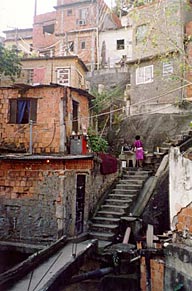Casestudy 18Brazil
Initiating inclusive processes at city scale
- description
- further information

© Alberto Lopez
Rio de Janeiro is characterized by divisions between the formal city and the favelas. The divisions affect every part of life, from access to health, education, transport and safety, to secure employment and influence over resource allocation and policy. Favela Bairro (‘slum-to-neighbourhood’) was a city-scale slum upgrading programme launched in 1994 by the Housing Department of the Municipal Government of Rio (SMH) with the support of the Inter-American Development Bank (IDB) to tackle the physical and social integration of Rio’s squatter settlements into the formal city. Through the implementation of upgrading projects in each of Rio’s medium-sized favelas, the objective was not only to improve living conditions for the urban poor, but to initiate a longer term process of integration on a city-scale, turning favelas into Rio neighbourhoods and their residents into citizens of Rio.
Favela Bairro tackled this issue through an integrated approach that attempted to provide favelas with access to services and infrastructure similar to those available in the rest of the city. The physical upgrading aimed to complement or construct basic urban infrastructure through the installation of basic sanitation and circulation systems, allowing for the free movement of people and vehicles (where possible), and better access to public services. At the same time, the programme introduced urban symbols of the formal city, such as roads, squares, infrastructure and a menu of social services from day care centres, adult education, job training to advice for securing land tenure to support social inclusion in the favelas. The underlying idea was that the ‘opening up’ of favelas to the outside world, and the creation of new public spaces, would transform the relationship between government and the local community, and trigger change at city-scale. In this way, urban integration was promoted as an instrument for comprehensive social inclusion.
A key to Favela Bairro’s success in meeting different causes and manifestations of urban poverty was its multi-sectoral character, and its implementation on a scale large enough to include the city as a whole.
At the project level, the programme aimed to impact on different aspects of urban poverty by allying infrastructure upgrading with social development initiatives, though in practice, the latter was often disregarded at the expense of the former. Each settlement project involved a large variety of different actors, ranging from architects and private construction firms to NGOs and many municipal government departments. Beneficiaries were also invited to participate throughout the project, though sometimes to a limited extent.
At the policy level, Favela Bairro involved more municipal departments and public sector bodies than any non-conventional housing programme previously implemented in Rio. The SMH quickly had to develop the skills to liaise, contract out and negotiate with a large number of actors. This was done with varying levels of success, as the skills needed to manage contracts with construction firms differ greatly from those needed to deal with architects, community groups and hostile drug traffickers.
The SMH was not fully prepared to promote and accept participation. It failed to delegate decision making powers to some actors, especially community organizations and NGOs representing the interests of the favela communities. The participation of favela residents was set within a top-down structure defined by the SMH. There were no mechanisms in place to systematically identify who the most vulnerable residents were within particular settlements and assess their specific needs. Moreover, a greater range of needs and problems could have been more effectively addressed if some municipal and state actors had been involved more fully. Control over the programme mostly remained in the hands of the SMH.
The lack of institutional mechanisms guaranteeing multi-sectoral cooperation between the different actors, including the necessary mechanism to secure the active involvement of the favela communities, was probably one of the major factors to undermine the continuity of Favela Bairro itself, as it was not able to resist the political fluctuations and changes of mood in public opinion over time. The programme slowed down by the newly elected Mayor in 2000. Since the latest municipal elections in 2004, it appears that it has gained in increased attention and political commitment again, yet in a very different context where most of the support from the public and the administration has been lost. Rising levels of violence associated with drug trafficking have negatively impacted on public opinion towards favelas. Their residents remain segregated from Rio’s formal life and political arena.
Through both its success and failures, the Favela Bairro experience shows that appropriate and institutionalized delegation of decision making and managing powers is essential in order to impact beyond settlement level to that of the city, with the potential to trigger true processes of social inclusion, in a sustainable manner. Horizontally, multi-sectoral coordination between the actors is needed, but there also need for vertical connections, down to civil society level.Go back to case studies listing
Brakarz, J., Greene, M. and Rojas, E. (2002) Cities for All: Recent Experiences with Neighborhood Upgrading Programs, Inter-American Development Bank, Washington DC.
Fiori, J., Ramirez, R. and Riley, E. (2000) Urban Poverty Alleviation Through Environmental Upgrading in Rio de Janeiro: Favela Bairro, DPU Research Report R7343, Development Planning Unit, London.
Fiori, J., Riley, E. and Ramirez, R. (2004) ‘Melhoria física e integração social no Rio de Janeiro: O caso do Favela Bairro, Brasil Urbano, MAUAD, Rio de Janeiro.
Websites:
IDB website with links to reports on Favela Bairro: www.idb.org
Rio de Janeiro municipal government website on the Favela Bairro programme: www.fau.ufrj.br/prourb/cidades/favela/frames.html
Housing Department of Rio’s municipal government website on the Favela Bairro programme: www.rio.rj.gov.br/habitacao/
University College London (UCL
